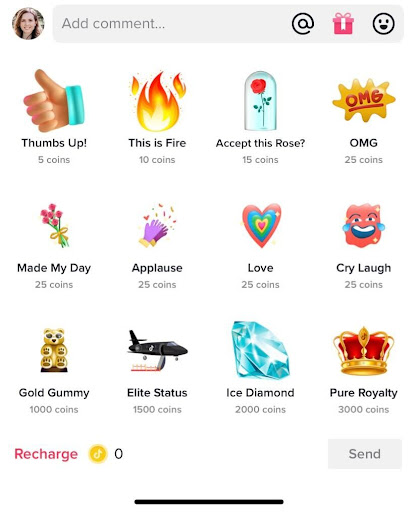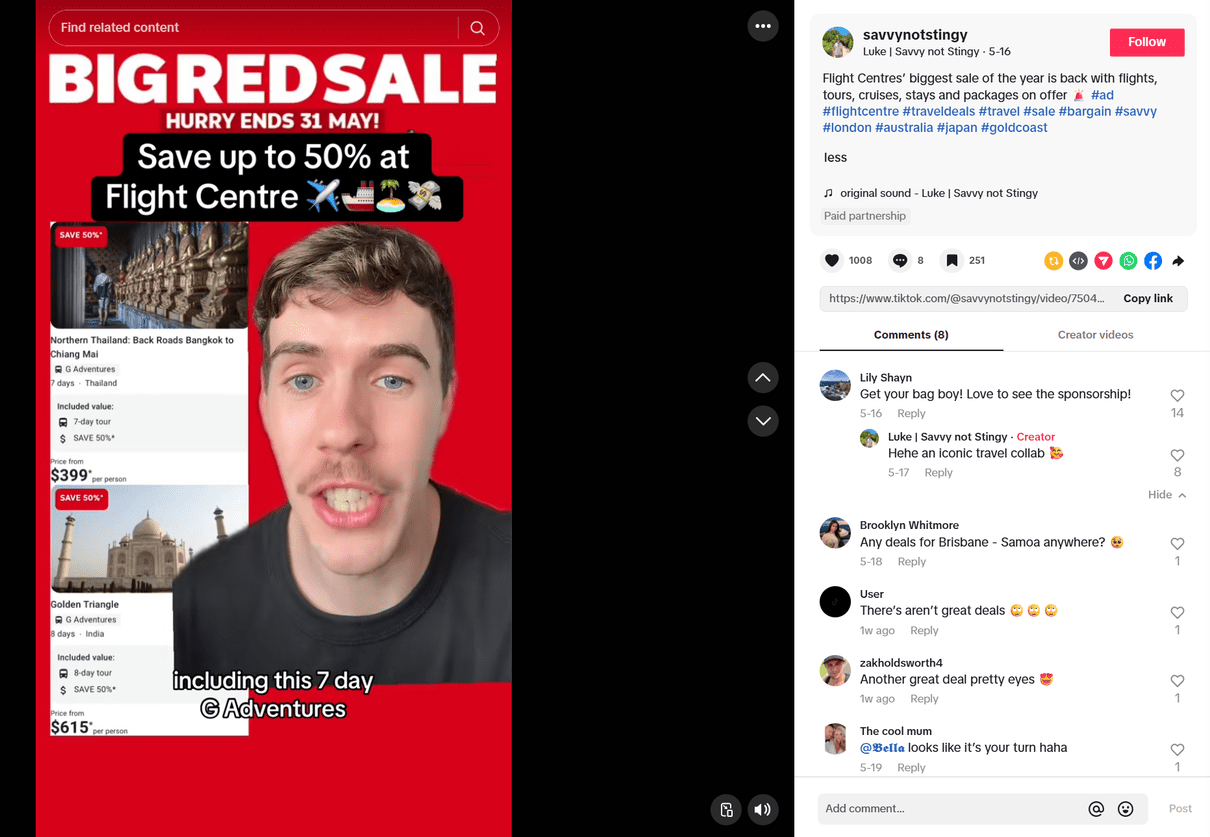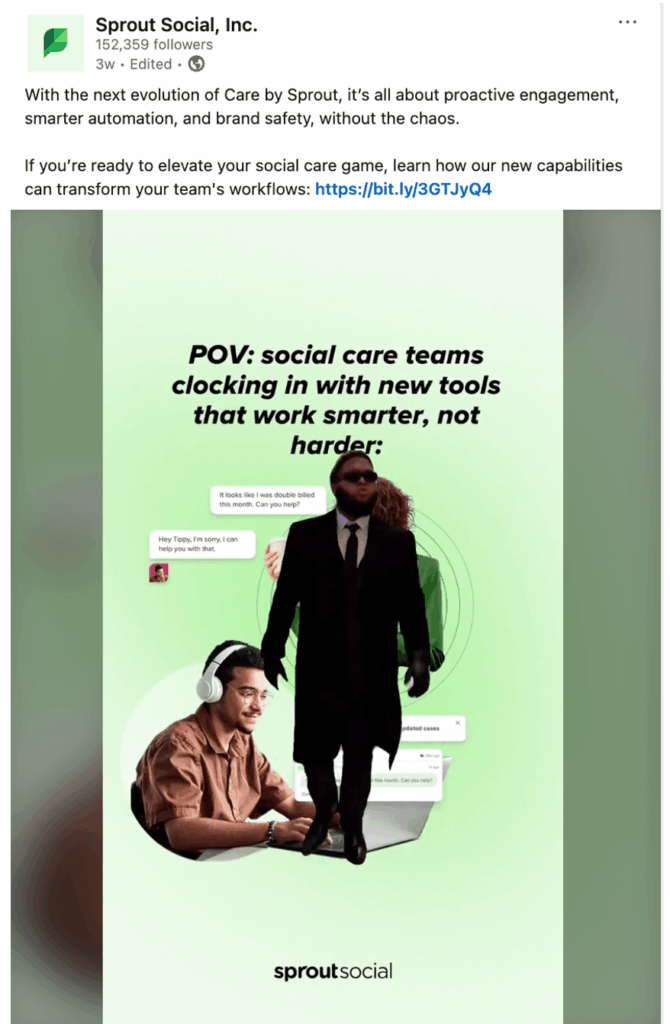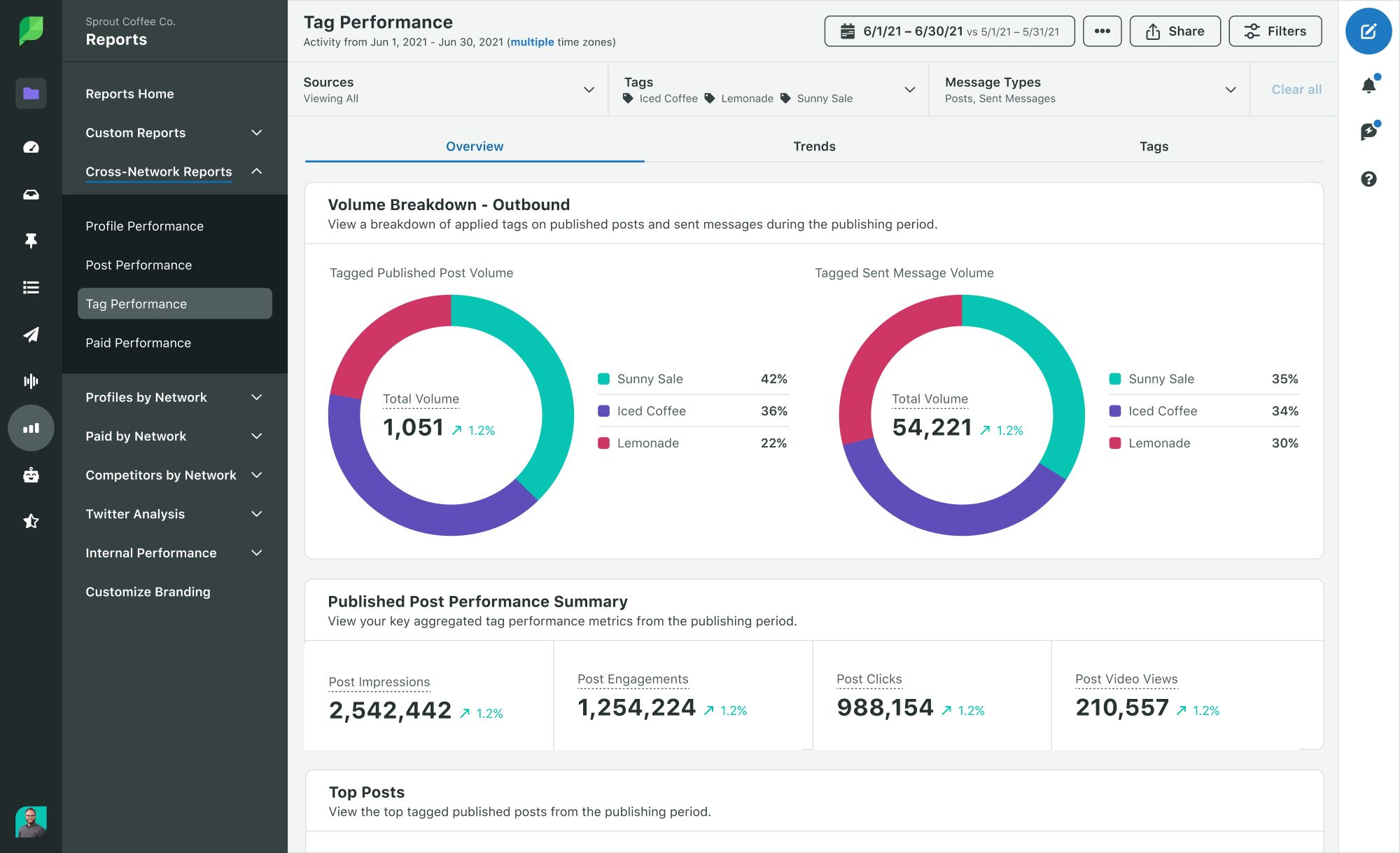With over 2.7 billion users, YouTube isn’t just a video platform—it’s a hub for connecting with audiences and building community. Getting the most out of this engagement, which is crucial for brand awareness and subscriber growth, starts with understanding YouTube metrics.
Whether you’re scaling your channel or improving your views and engagement, YouTube analytics helps you understand what works, where to optimize and how to tie your efforts to measurable outcomes.
We’ll break down the top YouTube metrics you should know about, how to build smarter strategies and how to tie your campaigns to ROI reporting.
Why YouTube data matters for your content strategy
According to the Social Media Content Strategy Report, 47% of YouTube users interact with brands every week. You can analyze interactions in YouTube analytics tools to learn, improve and report on your YouTube strategy.
Whether you’re using YouTube’s native analytics or a third-party tool, analytics data takes out the guesswork, which is crucial given the time and resources that go into creating and publishing videos. You can use this data to:
- Make YouTube content decisions: The data tells you what your target audience likes. Knowing if you have high video views, watch time and engagement for a certain video tells you what’s working and where there are opportunities to expand.
- Prove ROI: You need to connect your videos to business outcomes and analytics help you do that. For example, any conversions or spikes in product page traffic can connect back to your video and show that it’s made a difference for your company.
- Review video performance and adapt: YouTube analytics helps you create a tight feedback loop. If you want to improve watch time, for instance, start by analyzing the titles and thumbnails for your high-performing videos. What do they have that the other videos don’t? Or, look at the hooks of your top-performing videos. Are there types of hooks that pull viewers in to watch longer than others?
YouTube analytics help you double down on what’s working and strategically pivot when necessary.
How to access YouTube analytics
YouTube offers robust internal analytics that allow you to analyze your videos and engagement in real-time. Here’s how to access it:
- Sign in to YouTube and click on your profile icon. Choose YouTube Studio from the menu.

- On the left sidebar, click Analytics. From there, you’ll see your dashboard.

- Explore data in the Overview, Content, Revenue and Audience sections. When you click “See More,” you get more context about your channel and videos.

Engagement metrics that spotlight what’s working
Video engagement is complex, which is why you need multiple metrics to see what’s resonating. Here are some metrics you can start with:
Views
Views represent the number of times users watch your video (counted after 30 seconds).
Increase views by:
- Studying your most-watched videos: Identify commonalities in the headlines, topics, video descriptions and thumbnails (the details that capture audience attention and drive engagement).
- Collaborating with YouTube influencers or brands: Connect with creators or complementary brands to capture your target audience’s attention. They can introduce you to the right viewers and increase your channel’s exposure.
- Learning from trending videos and themes: Find relevant opportunities to join in on trending topics or challenges to increase reach and engagement.
As of March 2025, YouTube counts Shorts views differently, measuring a view every time a Short plays or replays—with no minimum watch time required. The older metric, now called Engaged Views, required a minimum video watch time. A best practice is to improve your hooks and promise value as fast as possible to keep viewers engaged and encourage rewatches.
Watch time
This metric measures the total hours your viewers spend watching your content. YouTube’s algorithm rewards videos with a high watch time, increasing their chances of discoverability.
Ways to increase watch time include the following:
- Posting videos consistently: Release videos on a regular schedule that sets audience expectations, builds viewer loyalty and encourages repeat visits. Returning viewership can lead to increased views and longer watch times.
- Increasing retention within videos: Produce intros that immediately hook viewers. Add pattern interruptions early with quick cuts, text overlays and engaging visuals to encourage higher watch times.
- Recommending videos: Feature follow-up content or use an End Screen to nudge users to view more.
Average view duration
Average duration reveals how long viewers stay and watch a video, helping you measure YouTube engagement and retention.
Along with the techniques mentioned for increasing watch time, apply these tactics:
- Changing visual components to grab attention: Change camera angles and add graphics, images, headers and other elements to shift patterns and keep viewers interested.
- Adding a cliffhanger: Promise value in your intros so users will want to finish or watch a video longer.
- Hosting YouTube livestreams: Viewers enjoy live videos. Host livestreams to interact with your audience in real-time, building community and generating longer watch times from live participation and views after the event.
Front-loading value can increase watch time. Deliver a good amount of your most entertaining and valuable scenes early on. Earning credibility early will increase retention on most of your videos.
Shorts were previously limited to 60 seconds. Now, they can be up to three minutes long. Unlike traditional YouTube videos, Shorts offer a unique key metric: swipes. Swipes provide helpful info on when viewers leave your video by swiping away. You can use this swipe data to fine-tune your Shorts and improve retention.
Audience retention
This metric tells you when you tend to lose viewers during the video. For example, was there a dip early on? That might be a sign to improve your intro or revisit topic relevance. Or was there a healthy, consistent curve? That might be a sign you’re connecting with your audience.
Audience retention is a great metric for studying viewer behavior throughout your video. Improve your channel performance by:
- Noting key moments: Pinpoint the moment viewers leave or stay engaged. Then, compare these retention trends across all your videos for commonalities and insights.
- Structuring new content based on retention curves: Apply the successful retention patterns you’ve analyzed to help you create future videos based on what’s working.
Retention looks different for Shorts. YouTube designed the format for quick views, encouraging users to watch many short videos in a short amount of time. While it can be challenging to keep retention high, even minor improvements can make a big difference in your Shorts’ performance. As you master retention in this competitive format, you can apply those techniques to your longer-form videos.
YouTube metrics that reveal your audience
Knowing who you’re reaching is the difference between a successful YouTube social media strategy and one that doesn’t get much traction. Follow these key metrics to find your viewers:
Demographics
YouTube demographics include details like age, gender, location and the devices your audience uses. This data helps you determine if your video content resonates with the right segment and if there’s an untapped group you might want to explore.
Impressions and CTR
Impressions refer to how often users see your video thumbnail in their feed or app, and click-through rate (CTR) is the percentage of users who click on the video. If you have a low CTR, your topic choice, title or thumbnail may need improvement.
In Sprout Social’s cross-platform Profile Performance Report, you’ll find impressions, engagements and key metrics for audience growth.
Subscriber gains (and losses)
The subscriber metric shows how many subscribers you’ve gained or lost—all based on video content. If your subscriber count increases, it’s a sign that your videos resonate with viewers. This can help you decide what kind of content you should publish in the future.
Unique viewers
This metric tells you how many people are watching your videos. A high unique-to-view ratio means you’ve got substantial reach. A lower measurement might indicate repeat views from loyal viewers.
Returning viewers
The returning viewer metric measures how many users returned to your YouTube channel. That’s a sign you’re building brand affinity, and a signal that your content is hitting home. You’re doing something right if this metric is growing.
Subscriber watch time
This metric shows you how long subscribers watched your videos. By comparing it with watch time from non-subscribers, you can uncover new insights, such as:
- More time from non-subscribers might mean you’re expanding your reach.
- More time from subscribers could mean you’re converting new accounts.
The good news for you is that you’re working in a favorable environment. YouTube has one of the largest shares of time spent on a video-sharing website. In 2024, analysts predicted US viewers would spend an average of 48.7 minutes daily on the site.
YouTube metrics that show viewer interest
Once you know who’s watching your videos, you can dig deeper by studying user behavior. Use these metrics to learn more about your viewers’ interests:
Likes, dislikes, comments and shares
These actions show how your content resonates with users. Comments and shares indicate depth of engagement, while other interactions, such as likes and dislikes, can suggest initial interest.
Engagement rate
YouTube calculates engagement rates based on your likes, comments and shares. It divides that number by views or impressions. This useful metric helps you gauge how your video connects with your YouTube audience.
Key moments for retention
YouTube also provides insights based on video spikes, replays and dips in your retention graph. This can help you discover what’s working and might be costing you viewers.
But it’s important to note that metrics vary depending on the format.
YouTube Shorts may achieve high retention and replays, while a traditional YouTube video might not reach the same high metrics but still produce deeper engagement and longer watch time.
YouTube metrics for tracking traffic sources
Traffic sources reveal where your views come from so you can refine your social media marketing strategy to produce conversions on your website. This attributable data is powerful information for your social media reporting. It’s undeniable proof that links your efforts to business outcomes.
YouTube’s native analytics include metrics such as impressions, views and average view duration in the data view connected with your traffic sources. Here are some YouTube metrics to look out for:
Traffic source types
You can easily see how viewers find your content with the following:
- YouTube search: If many viewers are finding your videos through search, it suggests an effective keyword strategy for video titles and subjects.
- Suggested videos: These videos appear to users who watch similar videos in your space. This signals you’re gaining traction with YouTube’s algorithm.
- Browse features: This shows your visibility on the homepage and subscription feeds.
- External sources: This metric shows how many people find your video off YouTube. Common examples include embeds on your website, Google or Bing searches or links from other social media channels. This is where keywords and SEO come into play.
CTR by source
For this specific YouTube key performance indicator (KPI), analyze your CTR by each source to improve future videos.
For example, compare how thumbnails and titles perform across different contexts, such as YouTube search, suggested videos and other traffic sources.
How to use YouTube data across channels
Integrating insights from multiple YouTube metrics empowers your social media team to craft a more effective strategy across all your social media accounts. Here’s how:
Spot high-performing content
As you test videos, you’ll discover some clear winners.
For your long-term strategy, analyze successful videos to identify commonalities—such as themes, thumbnails, production styles and more—and pinpoint what’s working on your audience.
These insights can inspire new content for your other social media accounts. For example, if a concept works well on YouTube, remix it into Instagram-native posts incorporating those themes. If a long-form video performs strongly, have your social content team repurpose it into multiple short clips for Shorts.
Strengthen your other social accounts
Cross-posting helps you reach a wider audience by increasing the visibility of your videos. Share videos across your social networks and make them feel native to each space. For example, you can repurpose your top-performing videos into LinkedIn clips or TikTok videos.
These steps are also crucial for boosting channel discovery and accelerating your YouTube channel’s growth. Consider these tactics:
- Include social handles in your YouTube video descriptions to direct viewers to your other social media channels.
- Use YouTube transcripts to pull captions and quotes for social posts on networks like X (formerly Twitter) or LinkedIn.
- Automate clips with tools like Descript.
- Start small and focus on just a couple of social media networks to learn from your strategy.
- Add a CTA for your original YouTube video, allowing viewers to dive deeper into the subject.
Align with business goals
Data offers immense value for any social media professional. By actively using data to learn and refine your strategies, you can tap into its full potential, which is crucial for effective social media management and reporting.
To communicate ROI and value to your stakeholders, you need to leverage your YouTube analytics. Your metrics should enable you to:
- Show brand awareness with impressions and unique viewers.
- Demonstrate engagement with returning viewers and user comments.
- Prove ROI with increased watch time on product videos and visits to tracked links or pages.
These kinds of analytic reports win over leadership and provide clarity to your YouTube strategy.
But managing multiple videos, tons of analytics and siloed data between social networks and tracking tools can be complex.
A robust social media management platform can simplify this process.
Take your YouTube marketing strategy further with Sprout Social
With Sprout, you can consolidate your entire social media strategy, enabling you to publish more effective social media content across channels. Our all-in-one platform seamlessly integrates with YouTube and your other social media accounts, delivering essential capabilities such as a unified dashboard for all your social media metrics, automated reporting to tie business goals to ROI and real-time engagement tools.
Start your free trial today to learn how to measure, manage and drive stronger results with your YouTube strategy.
The post YouTube metrics that drive growth and business impact appeared first on Sprout Social.
from Sprout Social https://ift.tt/GqXy3zN
via IFTTT




























































